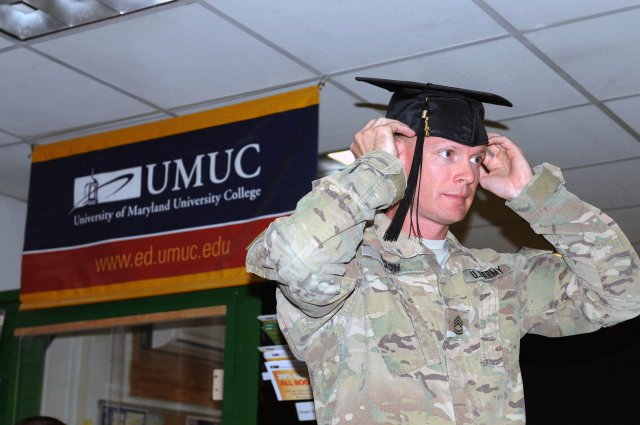…but sequestration is easy. Sequestration avoids all that hard stuff about negotiation, compromise, and putting things into adult perspective. You know: the things we pay our leaders to do.
Therefore, citizen, do not ask where the meat axe falls. It falls on you.
All four military services plus the Coast Guard have cancelled their education stipend for serving members. The tuition assistance program provided — up until last week, anyway — a maximum of $4,500 per year of tuition reimbursement at the rate of $250 per semester hour.
Let’s be clear about this. That rate doesn’t pay for some kind of Ivy League, “rule the Beltway” education. It gets deployed servicemembers into classes at University of Maryland extension campuses, CONUS troopies into local community colleges, and maybe into a land grant ag school if they’re lucky enough to be stationed nearby. It’ll knock a big hole through in-state rates at a public college, but wouldn’t even cover your lunch money at Stanford.
What it does is allow the people who defend the legislators who set the budget to get a leg up on supporting themselves once they leave the service. In an economy where veterans face an unemployment rate two points higher than those who weren’t foolish enough to serve their country, this might be construed as wise economic planning.
Nobody, from Chuck Hagel on down, is saying how much the Pentagon expects to save by completely suspending this popular and effective program, so let’s try and put it into perspective for ourselves, shall we?
Let’s take ten members each from the Army, Navy, Air Force and Marines, and start their education at a decent state university (since they’re members of the Department of Homeland Security, the Coast Guard can piss right off). That’s forty guys and gals who are directly charged with defending you from bad guys who want to kill you, and who want to improve their post-service life prospects during off-duty hours.
If each of them maximized the opportunity formerly offered to them under the tuition stipend, they could have taken 18 semester hours per year at a cost to taxpayers of $4,500 each, or $180,000 for all forty of them for the 2012 academic year. That’s about what it costs three (03) rich kids to go to Harvard for one year, but we’re not talking about millionaires’ fortunate progeny here.
What we’re discussing here is the cost to us, and what we get for our money. It’s pretty clear that in the case of educating young people in the military, we’re subsidizing the prospects of self-starters who feel a deep sense of duty to this country — you could think of it as a kind of DREAM Act for American soldiers.
So what do we get when we cut that money so we can spend it elsewhere? Let’s see, let’s see… oh, here’s one! The U.S. Customs and Border Protection Agency bought 10 shiny Predator drones to defend our borders from Mexicans and Canadians. Those freedom birds cost $20 million dollars each (that’s a “2” with seven zeroes behind it, for you liberal arts majors). If we’d bought nine aerial robots instead of 10, we could have paid for — can this be right? — around 4,400 living, breathing, taxpaying, sworn soldiers to go to college for a year. Of course, that would be downplaying the threat represented by the trade partners and allies who share our borders, and the strong popularity that federal domestic surveillance enjoys in the Land of the Free. Heck, they’re so popular that lobbyists are besieging your lawmakers for tax breaks to subsidize the domestic drone industry (yeah, I can hear you over there, wondering out loud why we need more tax breaks when we’re cutting the budget like a beer-addled weekend warrior with a weed whacker — you hush your unpatriotic mouth!).
Let’s look elsewhere, then.
How about the automakers’ bailout? Remember how that was supposed to have repaid the American people dollar for dollar and then some?
Not so very much.
Acting on your behalf, as the protector and assignor of your assets, the federal government loaned $12.4 billion to Chrysler Group. Last year, President Obama’s Treasury Department closed the books on ChryCo after it repaid $11.1 billion, leaving you and me (and those 40 enlisted and commissioned military personnel, too) holding the bag to the tune of $1.3 billion. Just for perspective, since that’s what we’re striving for here, that forgiven money is enough to give those 40 folks stipend enough for 7,222 years of schooling at last year’s rates. Call me a pie-eyed optimist, but I believe seven thousand years of college education could get even the most hardheaded grunt through a couple of graduate degrees.
Alternatively, we could could buy a few of these:
Of course, we need cars — not to mention jobs and such. And haircuts! Don’t forget the haircuts!
The Senate Hair Care shop, which charges United States senators and their staffers a flat $20 per haircut, ran a deficit in 2012 of $401,000. Now, admittedly, televised evidence proves that our Senate boasts some mighty good-lookin’ studs, but that tax subsidy to senatorial locks is enough to send our 40 earnest military troops through college for TWO years — with $41,000 left over to cover all the high and tight shaves they could possibly require. On the other hand, if the Senators just standardized on military haircuts themselves, their shop would be self-supporting — and we just found enough money to keep everyone happy!
Where else could we cut? Air Force One is just too fat a target — the professional (and recreational) time of the leader of the free world surely outweighs the academic prospects of 40 stalks of cannon fodder — but it is hard to overlook this remarkable coincidence: the $180,000 formerly budgeted to send 40 soldiers, sailors, Marines and airmen to school for a full academic year equals, almost to the penny, what it costs to operate President Obama’s personal jet.
For one hour.






 "Jack Lewis takes the overall literary crown with his new book...there’s a lot more to Lewis’s work than what it feels like to ride motorcycles.” — Ultimate Motorcycling
"Jack Lewis takes the overall literary crown with his new book...there’s a lot more to Lewis’s work than what it feels like to ride motorcycles.” — Ultimate Motorcycling
 "Insightful and from the heart ... a driven and much recommended look into the mind and conflict of the next generation of war veterans. " — Midwest Book Review (Reviewer's Choice)
"Insightful and from the heart ... a driven and much recommended look into the mind and conflict of the next generation of war veterans. " — Midwest Book Review (Reviewer's Choice)
Just for an example of what 250/sem. hr. will get a person, a five credit class at Clark College in Vancouver WA (which uses a quarter school year system, to hang in with the math, OK?) costs roughly $500. At the above reimbursement rate, the class is paid in full. Some classes have fees to cover materials used, but these are less than $100/quarter.
That makes the class essentially free for the student military member.
I know the exact costs of classes isn’t the point of your essay, but I thought that little bit of info might be a helpful addition in case it becomes part of a discussion.
It’s a good bargain, in my opinion, to have that one class per semester or quarter paid for by the taxpayers. Look at what we are getting in return.
I am working on my AAS out of South Seattle Community College. TA covers 100% of my tuition, to include books and lab fees. Well, it did anyway.
Right, Dan. Exact costs aren’t the point, only because comparing college to college is an apples to meatballs comparison. The now-suspended stipend covers “about half-time” at a state-subsidized college in a number of states. Realistically, half-time is plenty of extra-duty school for someone who’s hitting both formations every day while performing as a soldier.
As another example to go alongside your Clark College demonstration, full-time tuition at Washington State University (neither the most nor least expensive state university here) costs $11,386 per annum for in-state students. That’s a little more than double the maximum amount of the stipend. Rates for out-of-state students run $24,468 per year. No serving military member would be able to attend full-time without special dispensation from command, however (usually only available to officers and those studying to be officers).
On the other hand, part-time studies (defined as fewer than 10 credits per semester) costs only $569 for residents, and $1,223 for residents… easily coverable by the stipend, even when you add the semester fee of $914. Well-managed by a hard-charger, this could get a first-hitch gal well on her way to booting up a college degree following her service.
One may presume that rates vary considerably by state, and also by particular institution.
The program was supposed to be a leg up, and you better believe that it was used by recruiters to make service look more attractive to young people who weren’t in line to get a college degree on the Daddy Plan. Another promise to veterans gets broken, and everybody yawns.
This is my 1st time hearing this & I am disgusted! My 3 sons, in the service, did not give me this bit of info. I cannot believe this important promise has been broken & I pray it gets reinstated soon!
I’ve just read the program is being reinstated.
http://www.military.com/daily-news/2013/03/27/dod-restoring-tuition-assistance-for-all-services.html
‘Tis good news, Drift.
I’m not taking any credit for it, though. 😉